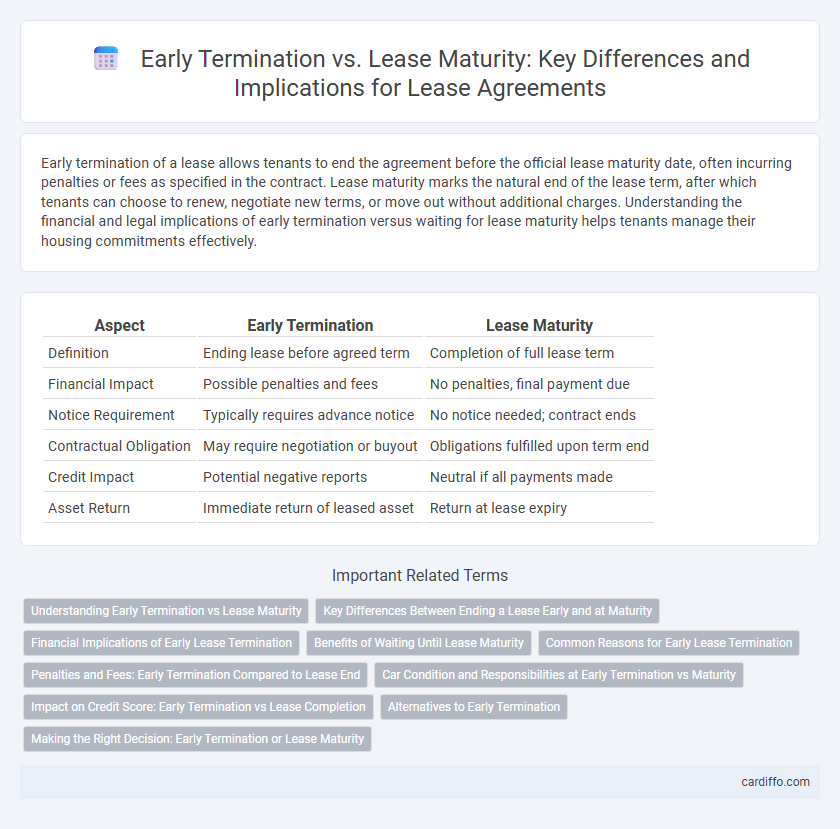Early termination of a lease allows tenants to end the agreement before the official lease maturity date, often incurring penalties or fees as specified in the contract. Lease maturity marks the natural end of the lease term, after which tenants can choose to renew, negotiate new terms, or move out without additional charges. Understanding the financial and legal implications of early termination versus waiting for lease maturity helps tenants manage their housing commitments effectively.
Table of Comparison
| Aspect | Early Termination | Lease Maturity |
|---|---|---|
| Definition | Ending lease before agreed term | Completion of full lease term |
| Financial Impact | Possible penalties and fees | No penalties, final payment due |
| Notice Requirement | Typically requires advance notice | No notice needed; contract ends |
| Contractual Obligation | May require negotiation or buyout | Obligations fulfilled upon term end |
| Credit Impact | Potential negative reports | Neutral if all payments made |
| Asset Return | Immediate return of leased asset | Return at lease expiry |
Understanding Early Termination vs Lease Maturity
Early termination of a lease involves ending the rental agreement before the specified lease maturity date, often resulting in penalties or fees outlined in the contract. Lease maturity signifies the natural conclusion of the lease term, after which tenants may choose to renew or vacate without additional charges. Understanding the distinctions between early termination and lease maturity is crucial for managing financial obligations and avoiding unexpected costs.
Key Differences Between Ending a Lease Early and at Maturity
Early termination of a lease occurs when a tenant ends the lease agreement before the specified maturity date, often incurring penalty fees or forfeiting the security deposit. Lease maturity signifies the natural conclusion of the lease term, allowing tenants to vacate without additional charges or negotiate renewal options. The key differences lie in the financial obligations, notice requirements, and potential legal consequences associated with ending a lease prematurely versus completing the full lease duration.
Financial Implications of Early Lease Termination
Early lease termination often results in significant financial implications, including accelerated rent payments, loss of security deposits, and potential penalties stipulated in the lease agreement. These costs can exceed the total rent payable until the original lease maturity, impacting a tenant's cash flow and budget forecasting. Understanding early termination fees and negotiating mitigation options can minimize the financial burden compared to waiting for lease maturity.
Benefits of Waiting Until Lease Maturity
Waiting until lease maturity maximizes financial benefits by avoiding early termination fees and penalties, preserving deposits, and preventing damage to credit scores. It allows tenants to fully utilize the leased property without interruptions, ensuring uninterrupted business operations or personal stability. Moreover, lease maturity often provides opportunities for negotiating favorable renewal terms or upgrades with landlords based on established tenant history.
Common Reasons for Early Lease Termination
Common reasons for early lease termination include job relocation, changes in financial circumstances, and property-related issues such as maintenance problems or safety concerns. Tenants may also terminate leases early due to family emergencies or dissatisfaction with management responsiveness. Lease maturity typically marks the natural end of a lease term, contrasting with these unexpected factors driving early termination.
Penalties and Fees: Early Termination Compared to Lease End
Early lease termination often incurs significant penalties, including early termination fees and potential forfeiture of security deposits, which are designed to compensate landlords for lost rent and re-letting costs. In contrast, lease maturity typically involves minimal or no fees, with tenants only responsible for final rent payments and any agreed-upon charges such as cleaning or repair costs. Understanding the financial implications of early termination versus lease end is crucial for tenants to avoid unexpected expenses and ensure compliance with lease agreements.
Car Condition and Responsibilities at Early Termination vs Maturity
At early termination of a car lease, lessees are typically responsible for any excessive wear and tear beyond normal use, and may face additional fees for damage or missing components. At lease maturity, the vehicle is generally returned in good condition, accounting for standard depreciation and mileage limits, with fewer penalties for minor imperfections. Understanding the specific lease agreement terms regarding car condition and responsibilities can help avoid unexpected costs during both early termination and lease maturity.
Impact on Credit Score: Early Termination vs Lease Completion
Early termination of a lease can negatively impact your credit score due to potential early termination fees and missed payments reported to credit bureaus. In contrast, completing a lease as agreed typically has a neutral or positive effect on credit, reflecting responsible financial behavior. Maintaining a good payment history throughout the lease term supports stronger creditworthiness and improves future loan or lease approvals.
Alternatives to Early Termination
Alternatives to early termination include lease subletting, lease assignment, and negotiating lease modifications with the landlord, which can help avoid penalties and preserve the tenant's credit rating. Tenants may also consider lease buyout agreements or temporary rent reductions as viable options to manage financial constraints without breaking the lease. Exploring these alternatives can provide flexibility while maintaining a lawful commitment until lease maturity.
Making the Right Decision: Early Termination or Lease Maturity
Evaluating early termination versus lease maturity requires assessing financial penalties, remaining lease term, and future space needs to optimize cost efficiency. Calculating the total lease obligations, potential sublease income, and market conditions ensures an informed decision aligned with business goals. Prioritizing long-term flexibility and minimizing expenses guides whether to exit early or fulfill the lease contract until maturity.
Early Termination vs Lease Maturity Infographic

 cardiffo.com
cardiffo.com